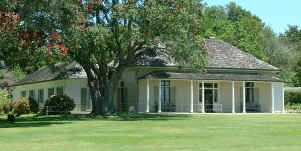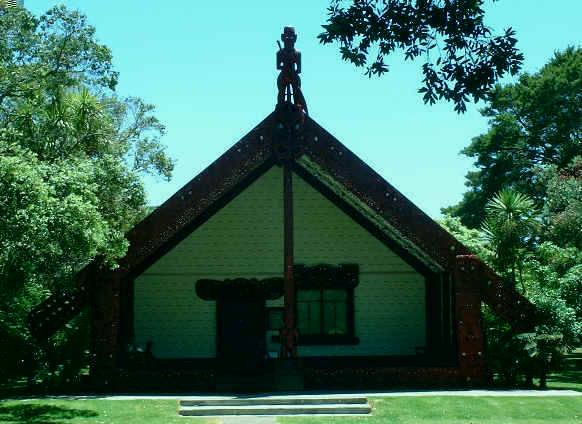| Waitangi National Reserve |

|
On February 5, 1840 Lieutenant-Governor William Hobson addressed a large
gathering of Maori chiefs assembled by missionaries at James Busby's house. The Maori came
by large canoes and assembled on the front lawn to debate and finally accept the Queen
Victoria's governorship. 46 chiefs signed the Treaty on February 6, 1840. The Treaty
guaranteed to the Maori possession of their lands, forests, fisheries and other valuable
property. In return the chiefs gave the Queen the sole right to purchase their lands.
The 35 metre long war canoe pictured above was built in 1940 as part of the
centennial celebration of the signing. It carries 80 warriors and is launched each year
for ceremonies commemorating the of the signing of the Treaty |
The Treaty House, one of NZ's oldest surviving buildings, is a fine example of
English Georgian Architecture. The frame of the house, and chimney bricks were shipped
from Sydney, Australia in 1833 and the house was completed in Waitangi. It was the home of
the first Resident Governor of New Zealand, James Busby, and the Treaty was signed on the
lawn in front of the house.
As originally built, it had only two rooms with a hall between and a kitchen and
"other offices" down a path at the back. After several years Busby complained to
his superiors in Australia that it was hardly large enough for his wife and children, let
alone for entertaining guests of the Crown.
There are still trees in the gardens which were planted in Busby's day when a
governor still had to feed his family from his own gardens and orchards. |
 |
|
 |
The Maori Meeting House, or Whare Runanga, was built for the 100th
anniversary of the signing of the Treaty. The Whare Runanga is a symbol of tribal prestige
and normally is a monument to the tribes ancestors. Because the Meeting House at Waitangi
was built for all the peoples of New Zealand, it has no name but its 28 interior panels
represent carvings from all of the Maori tribes in NZ.
Many of the designs were familiar to us from our wanderings in French Polynesia
especially the Marquesas. We were interested to notice a couple of panels representing
women, with the closed eyes typical of a female tiki. |
|
|
| Back to the Northland Map |
 S/V
TETHYS
S/V
TETHYS S/V
TETHYS
S/V
TETHYS